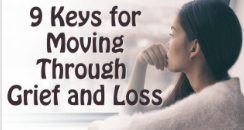First Key to Healing from Grief and Loss
Physical Injury
Imagine it is a cold January morning. You step out of your front door, planning to go for a walk or maybe to get the mail. You see that your front sidewalk is covered in snow. And as you step on to the sidewalk, you realize there is ice under the snow. You are certain you can navigate the icy sidewalk safely; you’ll just be sure to go slowly. And it goes well, for the first few steps. Then you feel your foot slip out from underneath you. In that split second you know that you are going down. As you are falling you automatically put out your arm in an attempt to catch yourself. When you land you know instantly you’ve broken your arm.
Okay, so you are on the ground with a broken arm what do you do? And how quickly do you do it? It’s easy to answer. You would get yourself to the ER as quickly as possible, either driving yourself or finding someone to take you. You would tell the nurses and doctors what happened. You would have your arm x-rayed in order to know exactly where the break was. You would have your arm set in a cast and deal with limited functioning in order to make sure your arm healed well.
Now consider what would happen if you had that same experience, you fell and broke your arm. But instead of getting to the ER you said, “I don’t have time to deal with this” or “it will heal on its own” or “maybe I’ll call someone about it next week.” Responding to a broken arm this way would mean you are going to be in a great deal of pain for a long time. And it’s unlikely your arm would heal on its own.
Okay, so of course this is silly, you wouldn’t respond to a broken arm this way.
You automatically take action and get support when you experience physical injury. The action you take can vary greatly based on the severity of the injury. It may be as simple as getting a band aid or as serious as open-heart surgery. When you don't take action or put off getting support after a physical injury there are consequences like prolonged pain and discomfort, infection, limited ability to function, and even death.
A different kind of open-heart surgery
It’s easy to see the importance of taking action and getting support after a physical injury. But what about for an emotional injury like loss? The importance of action and support after emotional injuries is often more difficult to see. You can't necessarily see emotional injury like you can a physical injury. There's no test you can take that will tell you where the break is. Adding to the difficulty in seeing the need for action and support can be messages you’ve taken in about emotional injuries. Are they real? Do they count? Or should you really just be able to “get over it?”
It’s common to have thoughts around emotional injuries like “this isn't that big of a deal” or “this shouldn't be that big a deal” or “I don't have time to deal with this.” You intentionally or unintentionally ignore, stuff, or minimize emotional injury. The problem with this response is that just like there are consequences when you don’t take action and get support with a physical injury the same is true for emotional injuries. These consequences could include things like depression, substance abuse, conflict in relationships, and potentially death.
Healing from an emotional injury, like loss, requires you to take action and get support. So, what does this action and support look like? Just as we discussed with physical injury, action and support for emotional injury can vary greatly. It can be as simple giving yourself permission to cry or it may be as serious as meeting with a therapist for an entirely different kind of open-heart surgery. Additional examples of action and support include journaling about what you’ve experienced, letting a friend or family member know that you're struggling, asking for time to talk, reading a book, joining a support group, writing a letter, or taking a class.
So, the first key to moving through loss is to understand that emotional injury, like loss, will not heal on its own – action and support are required.
My online course will teach you 8 additional keys for moving through grief and loss in a healthy way.
